Passion for Persimmons: Grower Strives to Commercialize the Seasonal Fruit
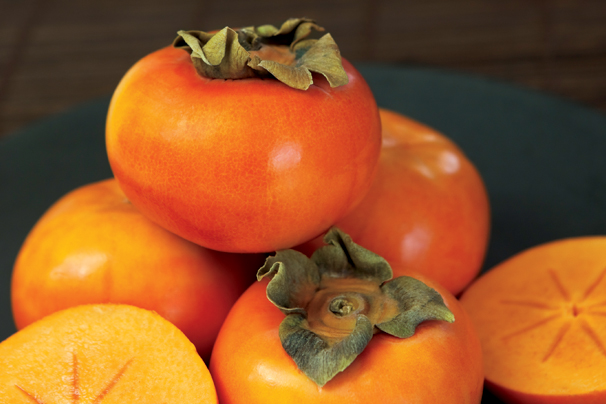
Editor’s note: We were sorry to learn that Jerry Lehman passed away in April 2019, but we can think of no better tribute to his legacy than leaving up this story about his persimmon farm.
When leaves start to turn brilliant colors in the fall, thoughts of favorite autumn foods come to mind. For many in Indiana, persimmon pudding and persimmon cookies are at the top of the list.
Terre Haute grower Jerry Lehman’s freezer is brimming with persimmon pulp always ready for his family’s beloved desserts. To say he’s passionate about persimmons wouldn’t be an exaggeration. In fact, Lehman is so enthusiastic about the globular, bright orange fruit that he has dedicated his retirement, nearly 15 years, to developing a persimmon tree that can be commercially produced in the United States.
An Indiana Persimmon Orchard
Raised on a farm in Berne, Lehman’s family instilled in him persistence and patience, traits key to starting his orchard in southwestern Vigo County and growing it to nearly 1,000 trees. Lehman and his wife, Barbara, use golf carts to traverse the orchards. He can cite the type of tree, planting date and fruit characteristics as if giving information about his grown children.
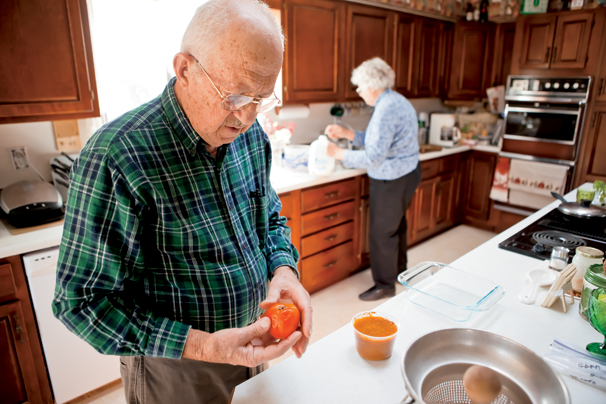
“Though there are about 20 farms producing persimmons in Indiana, there are no commercial persimmon growers like there are commercial apple orchards,” Lehman explains. “In my experimental orchard, I’m trying to develop a viable American persimmon tree with hardiness and quality. My goal is not to mass produce the fruit but work toward commercializing the American persimmon to benefit consumers and provide another avenue of income for Hoosier farmers.”
Much of Lehman’s 85-acre orchard is planted in American persimmon trees, but Asian persimmon trees have also been grown from seeds and cultivated in open pollination. They, too, dot his landscape and have been backcrossed to American trees.
See More
“The Asian fruit is really good and sweet and red in color,” says Lehman, the first fruit producer to import the Asian-American hybrid to the United States in 1992. Two years later, he became the second to grow and test the viability of the hybrid.
“My zest for growing persimmons comes from my mentor, the late Jim Claypool of St. Elmo, Ill.,” Lehman says. “He was considered the most prolific persimmon grower in the world.”
Claypool had some 2,400 hand-selected, pollinated trees and was looking for someone to carry on his work. When he died, his family allowed Lehman to move about 100 of Claypool’s trees to his Hoosier farm.
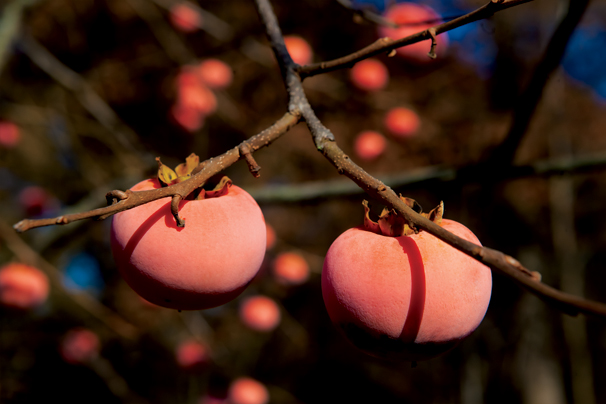
Growing and Storing Persimmons
Persimmon trees should grow in full sun and be spaced 25 feet apart, Lehman says. They are somewhat self-pruning and ideally should top out at 20 to 25 feet high. “You don’t want persimmon trees to grow too high because the fruit falls to the ground when it’s ripe and goes ‘splat,’ ” he says.
The trees, which can be purchased through catalogs for about $25, typically include varieties for early ripening, large and nearly seedless. Planting to fruit production takes about five to six years.
See more: Why Sedums Are the Perfect Fall Plant
According to Lehman, the best fruit harvest happens in mid-September to the end of October. Fully ripened fruit drops to the ground and should be picked up frequently. He warns persimmon lovers that the American fruit is not instantly edible.
“It is known to be ‘astringent’ – needs to ripen fully before it is fit to eat or be used in cooking,” Lehman says. “Not often can you pick persimmons and eat them right off the tree.” However, he notes that many Asian varieties are ‘non-astringent’ and can be eaten from the tree.
Persimmon Party
Remember, he adds, that persimmons must be pureed to create the pulp for end use in recipes such as pudding, bread and cookies. The pulp should be stored frozen unless it’s being used immediately. Persimmon pulp must be processed in federally inspected kitchens to be available at farmers markets, specialty groceries and gourmet food vendors. The fruit is rich in dietary fiber, low in calories and is known for its antioxidant compounds, such as vitamins A and C, beta-carotene and lycopene.
“I know persimmons are healthy for you,” Lehman says. “But I know what I enjoy, and persimmon pudding is my favorite dessert. And I’m just as happy eating persimmon cookies and bread.”
Try your hand at Lehman’s recipe for persimmon pudding.





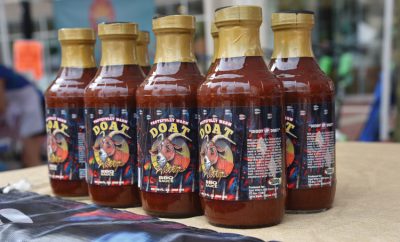

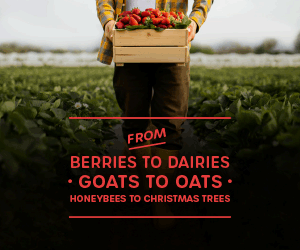

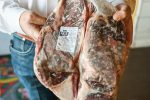
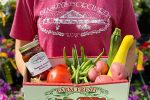


 My Indiana Home is produced for Indiana Farm Bureau members. Our mission is to connect you with the food you eat, the Indiana farmers who grow it and a rural lifestyle that is uniquely Hoosier.
My Indiana Home is produced for Indiana Farm Bureau members. Our mission is to connect you with the food you eat, the Indiana farmers who grow it and a rural lifestyle that is uniquely Hoosier.
Jerry Lehman
August 16, 2012 at 8:54 pm
I’d like to thank Indiana Home Magazine, especially Susan Hayhurst for the excellent article on persimmon. I’ve had more phone calls and E-mails from this article than any other ever written. That is the kind of attention needed to help promote the lowly persimmon to commercial status someday for Indiana orchard operators.
The trees are loaded this year with fruit and I’m sure it can all be marketed. One processor alone has said he wants the entire crop to pulp to freeze for resale and wholesale to farm and orchard markets. As another persimmon grower said, “The market is there, grow grow grow.”
David Kern
September 4, 2012 at 6:01 am
We have 2 persimmons trees, one Japanese and one American. The critters keep beating me to the fruit. Can I
pick them and let them ripen on the window sill as I would a tomato in order to beat the critters?
thanks
Jessy Yancey
September 4, 2012 at 8:16 am
Hi David,
Thanks for your comment. I’m not positive how it works with persimmons, so to find out about if they ripen off the vine, I’d recommend contacting Jerry Lehman at (812) 298-8733 or jwlehman@aol.com.
Thanks,
Jessy Yancey
editor
My Indiana Home
Jerry Lehman
September 6, 2012 at 7:31 am
Sorry to say once the persimmon is picked the ripening process basically stops. The cause of astringency is a chemical compound that absorbs moisture in the mouth but becomes insoluble in the mouth when ripe. However if picked very shortly before ripening the fruit can be placed in a container along with an apple or two and it will ripen. In Japan they ripen Asian persimmons by placing them in used Sake barrels. In China they ripen them overnight using a complicated warm water bath process. The bad news is persimmons ripened off the tree don’t develop the persimmon flavor as tree ripened then dropped to the ground.
Delolris Vogel
October 13, 2012 at 9:10 pm
We were wondering how to find your orchard once we arrive in Terre Haute. We would be traveling from Indianapolis. We take day trips with my siblings and saw your article in the Farm Bureau magazine and thought it sound interesting. We are all in our 70’s & 80’s and were raised on a farm so we all enjoy outdoor things.
Thank you for your time
Deloris
Rachel Bertone
October 15, 2012 at 3:20 pm
Hi Deloris,
For directions to the orchard and to request a tour, we recommend you contact Jerry Lehman at (812) 298-8733 or jwlehman@aol.com. Thanks for reading My Indiana Home!
Rachel Bertone
editor
My Indiana Home
Cherish Benge
November 24, 2012 at 3:58 pm
I have really enjoyed this article. I remember getting wild persimmons out in the woods with my grandma when I was a little lid. I am coming up on my 36th birthday and until this fall I don’t ever remember having a persimmon. They are so good! Thank you for sharing! I have a love for trees and would like to see yours sometime. I hope you do tours 😎
William Shepler
October 14, 2013 at 4:45 pm
i have 3 trees
1 is ripe large orange fruit
2 is begining to ripe has a purple hue but still green
3 tree is still green and smaller fruit
All three are with in 25 of each other, what’s the difference?
Bill
Steve York
April 25, 2015 at 4:25 pm
Hello sir, I was looking up persimmons because my great great grandfather Thomas C.Schnike had grafted wild persimmons with Japanese trees and came up with what I’ve heard and read a very nice grapefruit size persimmon. I was thinking about trying to do what he had done but, his notes were destroyed after he pass in 1948. I live on his farm now and would love see these trees here. A frost killed them off years ago.
Jessy Yancey
June 11, 2015 at 10:27 am
Hi Steve,
Thanks for your comment on our article about persimmons. To learn more about the production of this fruit, please contact Jerry Lehman directly at (812) 298-8733 or jwlehman@aol.com. Hope this helps. Thanks!
Jessy Yancey
editor, My Indiana Home
Hien
October 21, 2015 at 1:16 pm
I was born in Vietnam and came to Decatur, IN in 1975. After 31 years in Indiana, I had all but forgotten about persimmons. I was able to enjoy them again after moving to Southern California 9 years ago. I will be moving to Indianapolis in 2 years and started researching ways to plant persimmon trees there, I’m so glad to have come across this site and can’t wait to take a trip to Terre Haute!!!
Sherri
February 19, 2017 at 10:57 am
Do you have an dwarf asian percimmon trees for sale?